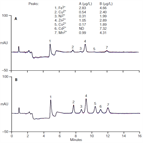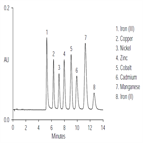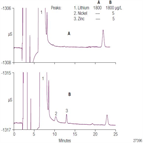Find methods for your needs
Refine by Feature
Displaying 1-5 of 8 results for Tag: nickel
AB108: Determination of Phosphite in Electroless Nickel Plating Bath
Instrument Type: ICElectroless nickel plating relies on a reducing agent, such as sodium hypophosphite, to deposit nickel phosphorous on the surface of an item. Over time, the hypophosphite in the bath will oxidize to phosphite. This Application Brief uses an IonPac AS17 column and a Regent-Free IC system to determine phosphite in an electroless nickel plating bath.
AU133: Saccharin in Electrolytic Nickel Sulfate Baths
Instrument Type: ICSaccharin decreases the tensile strength of electrolytic nickel deposits and can, with increasing concentrations, cause compressive stress. Determination of saccharin by ion chromatography is faster and has fewer interferences than classical titrimetric methods of analysis.
AU168: Determination of Transition Metals in Complex Matrices
Instrument Type: ICChelation ion chromatography facilitates the determination of low concentrations (μg/L and lower) of transition metals in samples including seawater, brines, estuarine waters, and a variety of biological samples. Here, the authors simplify the system configuration described in Technical Note 25, using an ICS-3000 system. The separation has also been updated to include the IonPac CS5A/CG5A column set, which demonstrates improved selectivity and peak efficiency for separation of transition metals compared to the CS5.
AN108:Determination of Transition Metals in Serum and Whole Blood by Ion Chromatography
Instrument Type: ICThe determination of transition metals in physiological fluids is of considerable interest in clinical chemistry. This application note describes an attractive alternative to traditional spectroscopic methods by using the principles of ion exchange. Separation between individual metals can be enhanced or altered simply by changing eluents (pyridine-2, 6-dicarboxylic acid or oxalic acid). This figure illustrates the selectivity on an IonPac CS5A column when using a pyridine-2, 6-dicarboxylic acid eluent.
AN250: Determination of Trace Nickel and Zinc in Borated Power Plant Waters Containing Lithium Hydroxide Using Nonsuppressed Conductivity Detection
Instrument Type: ICBoron as boric acid is used to control the nuclear reaction in pressurized water reactors (PWR) because of its strong neutron-absorbing characteristics. In addition, lithium is added to adjust the pH and zinc is added to suppress cobalt (58Co, 60Co) activity. Dissolved Ni in these solutions can be indicator of stress corrosion. To minimize corrosion, Ni and Zn monitoring is needed. Here µg/L of Ni and Zn in borated lithium water samples are determined on IonPac SCS-1 column and detected by non-suppressed conductivity. We recommend AN277 if sub-ppb detection is needed.





